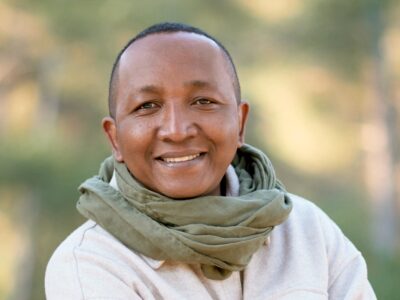Zachary Rosen entrevista al fotógrafo/poeta Amaal Said. Amaal nació en Dinamarca de padres somalís y actualmente reside en Londres:
AIAC: Your photographs are remarkable in how they challenge and evolve notions of beauty in mainstream Western media by featuring intimate portraits of melanin-rich young people – with piercings, in headscarves and with natural hair. What experiences inform and shape the content of your photographs?
Amaal Said: I try my hardest to keep close to beauty. I grew up in a neighbourhood referred to as a ghetto in Odense, Denmark. I went back two years ago and all I can remember is how many shades of green I saw. I wish I had captured more of it. My own memories of Odense are at odds with what I read about it and hear from family. It’s always been a beautiful place to me, which doesn’t mean that a lot of sadness and tragedy didn’t happen there, it just means that both elements can exist at the same time.
I’ve spent most of my life in London and I’ve had the pleasure of being in communities with other artists who are doing really important work in the world. I never felt alone in that case. Negative opinions of the countries we came from and the communities we lived in existed. I was in classrooms with other children who claimed that people that looked like me were dirty immigrants who stole jobs and cheated the system. I feel like I spent a lot of time at secondary school fighting people’s opinions. And I’m not in those particular classrooms anymore, but I’m still trying to combat those negative portrayals.
I never saw the documenting I did as particularly hard work. I asked to take people’s pictures because I found them beautiful, because I recognised myself in them. I realise now how important the work is and how necessary it is to push against the images that do not represent us in our best light.
AIAC: Sus fotografías son notables en cómo desafían y muestran la belleza en los principales medios de comunicación occidentales al presentar retratos íntimos de los jóvenes con mucha melanina – con piercings, con la cabeza cubierta y con el pelo natural. ¿Qué experiencias informan y dan forma al contenido de sus fotografías?
Amaal Said: Trato con fuerza de mantenerme cercano a la belleza. Crecí en un barrio al que se refería como gueto en Odense, Dinamarca. Volví hace dos años y todo lo que puedo recordar es cuantos tonos de manchas de verde vi. Me habría gustado capturar más de él. Mis propios recuerdos de Odense están en desacuerdo con lo que he leído y oído de mi familia. Siempre ha sido un lugar hermoso para mi lo que no significa que una gran cantidad de tristeza y tragedia no ocurrió allí, solo significa que ambos elementos pueden coexistir.
He vivido gran parte de mi vida en Londres y he tenido el placer de estar en comunidades con otros artistas que están haciendo un trabajo realmente importante en el mundo. Nunca me sentí solo en ese caso. Opiniones negativas de los países de donde venimos y de las comunidades de donde venimos existen. Estuve en salas de clases con otros niños que afirmaban que la gente que se parecía a mi eran inmigrantes sucios que robaron trabajos y engañaron al sistema. Siento que pasé mucho tiempo en la escuela secundaria luchando contra las opiniones de las personas. Y no estoy más en esas particulares salas de clases pero todavía estoy tratando de combatir esas representaciones negativas.
Nunca vi la documentación que hice como un trabajo particularmente difícil. Pido a la gente hacerle fotos porque los encuentro hermosos, porque me reconozco a mi mismo en ellos. Me doy cuenta cuan importante es el trabajo y cuan necesario es rechazar las imágenes que no nos representan en nuestro mejor momento.






